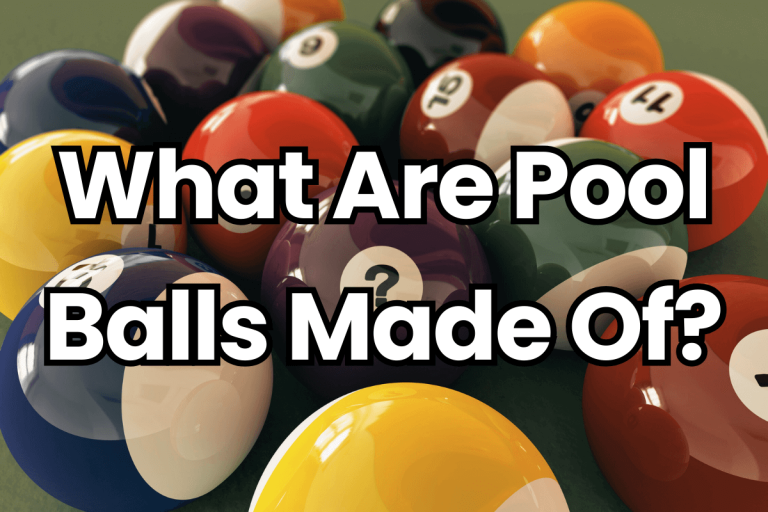Straight Pool Rules: how to play straight Pool better (2024)
Straight pool, traces its roots back to the 19th century, evolving from earlier cue sports. It soon cemented its place as a pillar in the pool realm, celebrated for its strategic depth and pure ball-potting prowess. Over the years, its popularity surged, influencing numerous championships and capturing the hearts of both spectators and players. Today, the straight pool holds a revered position in the billiards world, symbolizing both tradition and the timeless allure of the game.
This guide will cover all of the essential straight pool rules and How to play straight pool.
What is a straight pool?
Straight pool, also known as 14.1 continuous, is a pocket billiards game traditionally played on a pool table with fifteen object balls and a cue ball.
The primary goal of a straight pool is for the player to score points by pocketing any object ball into any pocket. Each ball pocketed counts as one point. A pre-determined point total (often 100 or 150 in professional settings) is set before the game, and the first player to reach that number wins.
Equipment Needed for Playing Straight Pool
Pool Table
- Size: Standard size is usually 9 feet by 4.5 feet, though there are variations.
- Markings: Usually has dots or “diamonds” on the rails for aiming and measuring shots.
Pool Balls
- Number: 16 balls – 15 object balls numbered 1 through 15 and 1 white cue ball.
- Color: Balls 1-7 are solid colors, 9-15 are striped, and the 8-ball is solid black.
- Significance: Every ball is worth one point when pocketed, irrespective of its number or color.
Cue Sticks & Accessories
- Cue Stick: A long stick used to strike the cue ball.
- Chalk: A small cube is applied to the cue tip to prevent slipping.
- Other Accessories: Racking triangle, bridge (for reaching distant balls), and sometimes a cue rack.
Basic Objectives of the Game
- Your main aim in the straight pool is to score points by pocketing the balls.
- Every ball you sink into a pocket earns you one point.
- The game starts with a special shot called the “break shot“.
- It’s important because it scatters the balls and begins the game. A good break can give you an advantage.
- The objective of this pool game is to be the first player to reach the agreed-upon point total (e.g., 100 points). Scoring is based on one point awarded for every object ball pocketed.
Straight Pool Rules
Breaking (Initiating the Game)
In a straight pool, the game’s starting point is the “break”. To decide who gets to break first, players can use methods like a coin toss. The player who gets the break must make a clear choice by calling out which object ball they intend to pocket and which pocket it’s going into. If, during the break, that chosen ball doesn’t go into the pocket, it’s still okay, but there are rules to follow for it to be a valid break. Specifically, at least two of the object balls and the cue ball must hit the rails (the sides of the table). This ensures a fair and skillful start to the game.
Here are some Best Break Cues for you…
Order of Play (Turn Sequence)
The order of play is quite straightforward. The player who can consistently pocket the balls they call and follow the rules gets to keep playing. However, if they miss a shot or make a foul, it’s time for the other player to take their turn. When only one ball remains on the table, all the other 14 balls are set up again in the triangle rack, ready for another round of play. This rule ensures that the game keeps moving smoothly and remains competitive.
Re-racking the Balls (Resetting the Ball Formation)
When it’s time to re-rack the balls in a straight pool, it’s usually a simple process. First, if the cue ball and the remaining object balls don’t get in the way of the racking, you just leave them where they are on the table. You take the 14 pocketed balls and set them up again in a triangle-shaped rack, leaving the top spot empty.
Now, if any of those balls obstruct the racking, here’s what you do: If it’s an object ball, you place it on the head spot or in the center spot if the cue ball is on the head spot. If it’s the cue ball that’s in the way, you move it behind the head string.
But, there are some special situations to note: If the fifteenth ball was pocketed along with the fourteenth ball, you’ll need to re-rack all 15 balls, and the cue ball goes in hand behind the head string. And if the fifteenth ball needs to be put back on the table due to a foul, but you haven’t touched the re-racked balls yet, you put it in the top spot of the racked balls. These rules help keep the game fair and clear.
Re-Breaking the Balls (Restarting the Game Initiation)
When it’s time for a re-break in the straight pool, the player who’s continuing their turn has a choice. They can either try to pocket the fifteenth ball or break the balls that have been set up in the rack again. If they decide to break the racked balls, just like in the beginning, they need to call out which object ball they aim for and which pocket they intend to sink it in. This gives them a fresh start to continue their run and score more points in the game. It’s a chance to keep the game going and show their skill.
Calling “Safety” (Announcing a Defensive Play)
In a straight pool, players have a tactical move called “calling safety” that they can use during their turn. When they decide to call “safety,” it means they’re taking a cautious approach before making their shot. After calling “safety,” they proceed with their shot as they normally would. But here’s the catch: if they happen to pocket any object balls during this shot, those balls are put back on the table, and no points are awarded. This ends the player’s turn, so it’s a way to play it safe and avoid risky situations in the game.
Scoring (Point Tallying)
In a straight pool, scoring is quite straightforward. When you pocket a ball legally, you get one point for it. If, during your shot, you manage to pocket multiple balls, you earn one point for each of those balls.
However, if things don’t go as planned, like if you miss the ball you called, put it in the wrong pocket, or pocket other balls instead of the one you called, there’s a rule to follow. Those balls that weren’t pocketed as intended are placed back on the table.
Also, if any balls go flying off the table during your shot, they too are put back in play. This scoring system helps keep the game fair and ensures that points are earned correctly.
Fouls (Rule Violations)
In a straight pool, fouls can happen, but they’re pretty straightforward. If a player makes a standard foul, like scratching, shooting a ball off the table, or forgetting to call the pocket for a ball, they get a one-point penalty. This means one point is taken away from their current score.
But here’s the thing: there’s no penalty for pocketing a ball illegally. Instead, if that happens, the ball simply goes back on the table. So, fouls are a way to keep the game fair, and they come with a small penalty to remind players to be careful with their shots.
Consecutive Fouls (Successive Rule Breaches)
In a straight pool, there’s a rule about consecutive fouls, but it’s pretty straightforward. If a player commits three fouls in a row, it’s considered a serious penalty. But here’s the key: these three consecutive fouls only count if they’re standard fouls, not breaking fouls.
After the third standard foul, you do what you normally do for a foul and deduct one point from your score. But here’s the twist: you also get a big 15-point serious penalty foul that you have to subtract from your score.
Now, your foul count goes back to zero, and here’s where it gets interesting: the other player can ask for all fifteen balls to be set up again, and you have to break them legally. If you break illegally, breaking fouls will apply. This rule makes sure the game stays fair and players follow the rules to the letter.
Breaking Foul (Game Start Violation)
When a player commits a breaking foul, which happens when they either don’t pocket a called ball or if they don’t send at least two balls to the rail during the break shot, there’s a two-point penalty. This means two points are taken away from their current score.
Here’s the interesting part: the other player has a choice. They can either accept the balls as they are on the table, or they can ask the player who broke them to set up the balls again and try the break shot once more. If the player who broke commits another breaking foul during the re-break, two more points are deducted from their score. This process continues until they break legally or the other player accepts the balls on the table as they are. It’s a way to make sure the game starts right and follows the rules.
Playing Techniques and Strategies Simplified
- Position Play: This is about controlling the cue ball. It’s like making sure the cue ball goes where you want it to after you hit it. It helps you set up for the next shot.
- Break Shots: These are the shots you take at the beginning of the game. There are tricks to making these shots work well every time.
- Defensive Play: Sometimes, it’s smart to play it safe. Defensive play means you’re careful not to give your opponent easy shots. You might not try to pocket a ball, but instead, make it hard for your opponent to do so.
- Understanding Patterns: In the game, balls are often set up in certain ways. Recognizing these patterns helps you plan your shots and take advantage of the best opportunities to score. It’s like finding the best path to victory.
Conclusion
Straight Pool is a challenging and rewarding game that requires skill, precision, and strategy. To play straight pool, you must call your shots before shooting and pot 14 balls before your opponent. If you are new to straight pool, we encourage you to read this guide carefully and practice regularly. With time and effort, you can become a skilled and successful straight pool player.
FAQs
1. What is the difference between a straight pool and a 15-ball pool?
The main difference between a straight pool and a 15-ball pool is that in a straight pool, players must call their shots before shooting. This means that they must tell their opponent which ball they intend to pot and into which pocket they will pot it. In a 15-ball pool, players do not have to call their shots
2. Is a straight pool suitable for beginners?
Yes, straight pool can be enjoyed by players of all skill levels. It’s a great game for beginners to learn essential cue sports skills and strategies.
3. How is straight pool different from other pool games like 8-ball or 9-ball?
In a straight pool, you can pocket any ball in any order, and there’s no need to follow a specific sequence like solids or stripes. It offers more freedom and strategy.
4. What’s the highest possible score in a straight pool?
In theory, there is no maximum score in a straight pool, as players can continue to pocket balls and re-rack. However, professional games are typically played to a predetermined point total, such as 100 or 150 points.
5. What is “safety” in straight pool?
A “safety” in straight pool is when a player declares that they do not intend to pot a ball on their shot, but rather to position the cue ball in a way that will make it difficult for their opponent to score. This is often done when a player is in a difficult position and does not want to risk fouling.







